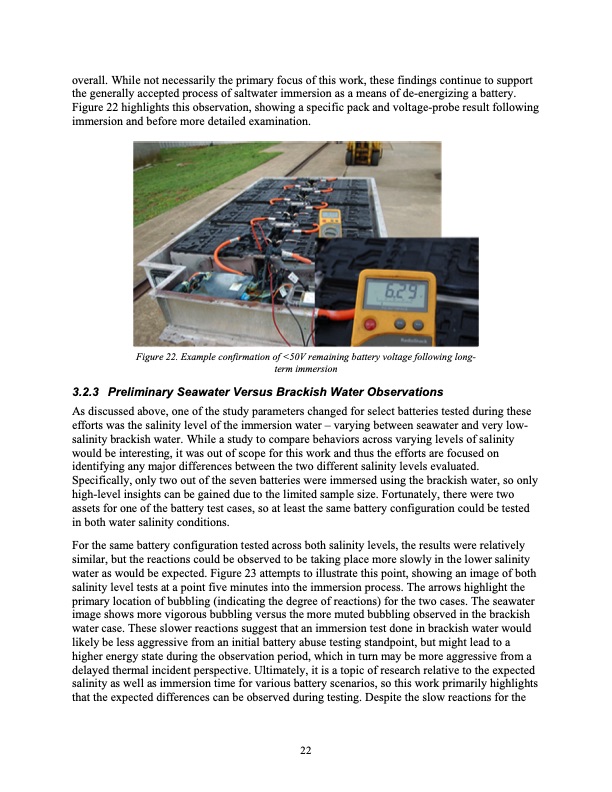
PDF Publication Title:
Text from PDF Page: 026
overall. While not necessarily the primary focus of this work, these findings continue to support the generally accepted process of saltwater immersion as a means of de-energizing a battery. Figure 22 highlights this observation, showing a specific pack and voltage-probe result following immersion and before more detailed examination. 3.2.3 Preliminary Seawater Versus Brackish Water Observations As discussed above, one of the study parameters changed for select batteries tested during these efforts was the salinity level of the immersion water – varying between seawater and very low- salinity brackish water. While a study to compare behaviors across varying levels of salinity would be interesting, it was out of scope for this work and thus the efforts are focused on identifying any major differences between the two different salinity levels evaluated. Specifically, only two out of the seven batteries were immersed using the brackish water, so only high-level insights can be gained due to the limited sample size. Fortunately, there were two assets for one of the battery test cases, so at least the same battery configuration could be tested in both water salinity conditions. For the same battery configuration tested across both salinity levels, the results were relatively similar, but the reactions could be observed to be taking place more slowly in the lower salinity water as would be expected. Figure 23 attempts to illustrate this point, showing an image of both salinity level tests at a point five minutes into the immersion process. The arrows highlight the primary location of bubbling (indicating the degree of reactions) for the two cases. The seawater image shows more vigorous bubbling versus the more muted bubbling observed in the brackish water case. These slower reactions suggest that an immersion test done in brackish water would likely be less aggressive from an initial battery abuse testing standpoint, but might lead to a higher energy state during the observation period, which in turn may be more aggressive from a delayed thermal incident perspective. Ultimately, it is a topic of research relative to the expected salinity as well as immersion time for various battery scenarios, so this work primarily highlights that the expected differences can be observed during testing. Despite the slow reactions for the Figure 22. Example confirmation of <50V remaining battery voltage following long- term immersion 22PDF Image | Li-Ion Battery Pack Immersion Exploratory Investigation

PDF Search Title:
Li-Ion Battery Pack Immersion Exploratory InvestigationOriginal File Name Searched:
dot_57013_DS1.pdfDIY PDF Search: Google It | Yahoo | Bing
Product and Development Focus for Salgenx
Redox Flow Battery Technology: With the advent of the new USA tax credits for producing and selling batteries ($35/kW) we are focussing on a simple flow battery using shipping containers as the modular electrolyte storage units with tax credits up to $140,000 per system. Our main focus is on the salt battery. This battery can be used for both thermal and electrical storage applications. We call it the Cogeneration Battery or Cogen Battery. One project is converting salt (brine) based water conditioners to simultaneously produce power. In addition, there are many opportunities to extract Lithium from brine (salt lakes, groundwater, and producer water).Salt water or brine are huge sources for lithium. Most of the worlds lithium is acquired from a brine source. It's even in seawater in a low concentration. Brine is also a byproduct of huge powerplants, which can now use that as an electrolyte and a huge flow battery (which allows storage at the source).We welcome any business and equipment inquiries, as well as licensing our flow battery manufacturing.| CONTACT TEL: 608-238-6001 Email: greg@salgenx.com | RSS | AMP |